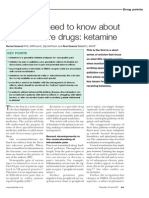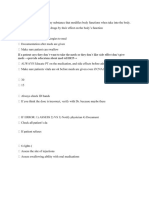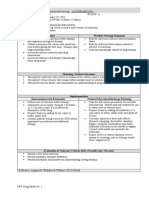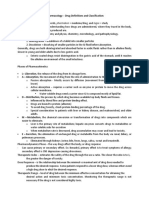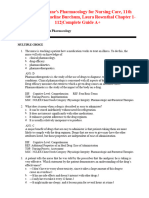Range Order Proceedure 1
Range Order Proceedure 1
Uploaded by
mauchkCopyright:
Available Formats
Range Order Proceedure 1
Range Order Proceedure 1
Uploaded by
mauchkCopyright
Available Formats
Share this document
Did you find this document useful?
Is this content inappropriate?
Copyright:
Available Formats
Range Order Proceedure 1
Range Order Proceedure 1
Uploaded by
mauchkCopyright:
Available Formats
Center for Change Policies and Procedures
Medication Range Orders Procedure
Section: Medication Management Reference No: 9-204
Effective Date: January 2004 Revised: 1/2007; 6/5/2008
Purpose
Range orders, if written appropriately, can be a tool for customizing patient
care based on the patient condition and their response to therapy.
Inappropriate range orders, however, can lead to confusion and
medication errors. The purpose of this procedure is to outline appropriate
ordering and interpretation of medication range orders.
Scope
This procedure applies to all Center for Change facilities. This includes all
professionals involved in the medication management process.
Definitions
Medications
Prescription medications, sample medications, herbal remedies,
vitamins, nutraceuticals, over-the-counter drugs, vaccines,
radioactive medications, respiratory therapy treatments, parental
nutrition, blood derivatives, intravenous solutions, any product
designated by the Food and Drug Administration (FDA) as a drug.
For this procedure, medications do not include enteral nutrition
solutions, oxygen and other medical gasses, which is the Joint
Commission on Accreditation of Healthcare Organization’s
(JCAHO) definition.
Range Order
A range order is a medication order where the medication can be
given over a specified dosage range.
Procedure
1 There are a number of considerations for writing and interpreting range orders:
1.1 Patient’s Prior Exposure to Medication: The patient should receive
the lowest effective dose. If a patient has recently received the
medication with inadequate results then a higher dose within the range
may be used.
1.2 Prior Response: The caregiver should evaluate the patient’s response
to previous doses, which should include efficacy and adverse effects.
1.3 Age: For the very young and elderly, start with the lowest dose and
titrate the dose slowly and carefully. Frequent assessments are required
for these populations.
Medication Management Page 1 of 3
Medication Range Orders Procedure
Center for Change Policies and Procedures
1.4 Hepatic and Renal Function: If the patient has hepatic or renal
insufficiency, anticipate a more pronounced peak effect and longer
duration of action.
1.5 Severity of Symptoms: As a general rule for moderate to severe pain,
increase the dose by 50% - 100%. Do not increase by more than 100%
at one time. To fine – tune the dose once pain is mild, titrate by 25 –
50%.
1.6 Pharmacokinetics of the Medicine: The onset, peak, and duration of
action should be considered when prescribing and assessing the effects
of the medication.
1.7 Co morbidities that may affect Patient Response: An altered dose
may be necessary in a person with one or more co morbidities. For
example if a patient is to receive an opioid and has respiratory
insufficiency, a lower dose should be used.
1.8 Concomitant Administration with Other Medications: Medication
regimens should be adjusted when a combination of medications will
result in increase or decrease side effects or therapeutic effects. For
example, when a CNS depressant is given with an opioid, the desired
effect or undesired effect (e.g.. over-sedation) may be achieved with
doses 30% - 50% less than when each medication is given alone.
1.9 Combination Drugs: When prescribing a combination product, the
maximum possible dose of each medication should be considered, such
as when prescribing an opioid with acetaminophen (should not exceed
4000m.g. of acetaminophen in 24 hours).
2 The following components are necessary for a valid Range Order:
2.1 Completeness of Order: All components as outlined as outlined in the
Medication Management Policy are required for a complete order.
2.2 Reasonable Dosage Range: The maximum dose should not be larger
than four times the minimum dose. In addition, the maximum dose
cannot exceed the maximum recommended dose for that medication.
2.3 A single Time Interval: Dosing interval ranges are not allowed. If an
order includes an interval range, it will be transcribed with the most
frequent interval allowed. For example, an order for every 3-4 hours as
needed will be interpreted as every 3 hours as needed. The prescriber
does not need to be contacted for this change.
3 Interpretation of Range Orders:
3.1 When implementing range orders, the nurse should assess the need of
the patient and the potential effect of the other factors as listed in 1.1-1.9.
3.2 Nurses will administer medications that are prescribed in ranges by
utilizing lower doses when symptoms are assessed to be less severe
and may provide the higher doses when symptoms are more severe (see
example A below).
3.3 Medications with an Increased Risk of Adverse Events:
3..3.1 The lowest dose should be used initially for medications with an
increased risk of adverse events, such as central nervous system (CNS)
Medication Management Page 2 of 3
Medication Range Orders Procedure
Center for Change Policies and Procedures
depressants (i.e., benzodiazepines and opioid derivatives), antipsychotic
medications (i.e. phenothiazines) and cardiovascular medications, unless
other wise specified in the order. If symptomatic relief is not obtained
within the expected time frame, the nurse may administer additional
medication not to exceed the maximum ordered dose (see example B
below).
3.3.2 If patients have been successfully treated (good efficacy and
tolerable side effects) with the same medication (e.g. opioid tolerant
patients), the dose used previously may be administered initially
provided that it falls within the dose range specified in the order.
3.4 If supplemental doses are given during the interval time period, the total
amount cannot exceed the maximum dose ordered for that time interval.
The time interval is measured from the time of the initial dose. If the
maximum dose is reached and the desired effect has not been achieved,
the prescriber should be contacted
Example A:
Diphenhydramine 25 to 50 mg orally every 6 hours as needed for itching
or hives is ordered. If the patient begins itching, a 25 mg dose may be
appropriate. If the patient has hives, the 50 mg dose may be
appropriate. Example B: The following is ordered for opioid-naïve
patient: Morphine sulfate 2 mg to 6 mg IV every 2 hours as needed for
pain. An initial dose of 2 mg is given. The assessment at 15 minutes
after the dose indicates the patient is tolerating the medication but is still
in severe pain. Additional medication, up to 4 mg may be given to
control the pain. No more than 6 mg may be given during the 2-hour
interval period. Subsequent doses can be administered no sooner than
2 hours from the initial administration. If this adequately controls the
patient’s pain, the following doses can be up to 6 mg. If pain is not
controlled and the maximum dose has been reached, the prescriber
should be contacted.
Exceptions
None
Secondary Materials
W.B. Saunders, The Use of as needed Range Orders in the management of Acute Pain:
A Consensus Statement of the American Society of Pain Management Nursing and the
American Pain Society: Pain Manag Nurse 5(2): 53-58, 2004.
Medication Management Page 3 of 3
Medication Range Orders Procedure
You might also like
- Lehnes Pharmacology For Nursing Care 11th EditionDocument582 pagesLehnes Pharmacology For Nursing Care 11th EditionIrfan Ali100% (3)
- Nursing-Process-Focus-Drug-Study-Template Special AreaDocument8 pagesNursing-Process-Focus-Drug-Study-Template Special AreaRose RanadaNo ratings yet
- Controlled DrugsDocument9 pagesControlled DrugsAbdelrhman AboodaNo ratings yet
- Types of Medication OrdersDocument2 pagesTypes of Medication OrdersAndrei Caraiman67% (3)
- Cdi MockboardDocument11 pagesCdi MockboardSherwin Bryan Malabanan80% (5)
- ATI FinalPharmacologyDocument7 pagesATI FinalPharmacologyClaudia Manning100% (17)
- Medication Use Policy - AMHCDocument21 pagesMedication Use Policy - AMHCeliasNo ratings yet
- Slu Pcal Notes PDFDocument7 pagesSlu Pcal Notes PDFMieNo ratings yet
- Clinical Paractis Paperghazanfar AYazDocument7 pagesClinical Paractis Paperghazanfar AYazassassain creedNo ratings yet
- Chapter 6Document39 pagesChapter 6A kNo ratings yet
- Introduction To Pharmacology Part IIDocument46 pagesIntroduction To Pharmacology Part IINada AlhaririNo ratings yet
- Skills Laboratory: MedicationDocument183 pagesSkills Laboratory: MedicationJam PasionNo ratings yet
- What GPs Need To Know About KetamineDocument4 pagesWhat GPs Need To Know About KetamineAdiAri RosiuNo ratings yet
- Pharm - NSG Science - Ppt.prevised2Document86 pagesPharm - NSG Science - Ppt.prevised2RAINBOW40No ratings yet
- Rational Prescribing & Prescription Writing: IntroductionDocument3 pagesRational Prescribing & Prescription Writing: IntroductionAnmol KudalNo ratings yet
- Article134 138Document5 pagesArticle134 138Ahmad Farid HabibyarNo ratings yet
- Ketamine Infusion For CRPS or Opioid Weaning GuidelineDocument14 pagesKetamine Infusion For CRPS or Opioid Weaning GuidelineAlia SandoQaNo ratings yet
- Administering Medication NotesDocument9 pagesAdministering Medication NotesCyriel DicoNo ratings yet
- Medication FileDocument21 pagesMedication Filequin8737No ratings yet
- 2101 Chapter 1 Part 2Document13 pages2101 Chapter 1 Part 2No IdeaNo ratings yet
- Adapted From CDC Guideline: Assess Pain & FunctionDocument2 pagesAdapted From CDC Guideline: Assess Pain & FunctionSolomon Seth SallforsNo ratings yet
- Adverse Effects of DrugDocument20 pagesAdverse Effects of DrugABARNA ABINo ratings yet
- Milv 10N4Document4 pagesMilv 10N4garywall.ukNo ratings yet
- Clinical Pharmacy Complete Notes-CompressedDocument355 pagesClinical Pharmacy Complete Notes-CompressedM. Huzaifa Nasir100% (1)
- MonitoringDocument65 pagesMonitoringk44218386No ratings yet
- Pharma Midterm ExamDocument16 pagesPharma Midterm ExamChriscel Ann EspirituNo ratings yet
- Medication AdministrationDocument56 pagesMedication AdministrationErika MarieNo ratings yet
- PCA: The Indications For and The Advantages and Disadvantages of Patient Controlled AnalgesiaDocument3 pagesPCA: The Indications For and The Advantages and Disadvantages of Patient Controlled AnalgesiaNaser MuhammadNo ratings yet
- PocketGuide FINAL6 PDFDocument2 pagesPocketGuide FINAL6 PDFSolomon Seth SallforsNo ratings yet
- Case Scenario Drug Study - VicenteDocument4 pagesCase Scenario Drug Study - VicenteLouraine VicenteNo ratings yet
- New Topics in phaRMcology (97-2003)Document18 pagesNew Topics in phaRMcology (97-2003)api-3761895No ratings yet
- PHCL Midterms - Lesson 1 (Calculation of Doses General Consideration)Document4 pagesPHCL Midterms - Lesson 1 (Calculation of Doses General Consideration)Lazaro, Javen Andrie A.No ratings yet
- Acute Post-Op Pain ManagementDocument4 pagesAcute Post-Op Pain Management1234chocoNo ratings yet
- Rational Use of DrugsDocument2 pagesRational Use of DrugsRajan Manandhar ShambhavNo ratings yet
- MEDICATIONSDocument16 pagesMEDICATIONSCynthia LuayNo ratings yet
- Drug Study: 200 MG ODDocument2 pagesDrug Study: 200 MG ODSophia Kaye AguinaldoNo ratings yet
- Safe PrescribingDocument4 pagesSafe PrescribingSinging MedicNo ratings yet
- 2.mood Disorder TreatmentDocument56 pages2.mood Disorder TreatmentREDEEM NNo ratings yet
- Fundamental Concepts of PharmacologyDocument21 pagesFundamental Concepts of PharmacologyYean Delos ReyesNo ratings yet
- Good PrescribingDocument20 pagesGood Prescribingbil sitNo ratings yet
- Neuropathic Pain Guidance April 2023 v1.2Document6 pagesNeuropathic Pain Guidance April 2023 v1.2Germán Bernate ObandoNo ratings yet
- Clinical PharmacokineticsDocument1,135 pagesClinical PharmacokineticstayhodgesNo ratings yet
- Tri Widyawati - Jazanul Anwar: Department of Pharmacology and Therapeutics Faculty of Medicine, Universitas Sumatera UtaraDocument41 pagesTri Widyawati - Jazanul Anwar: Department of Pharmacology and Therapeutics Faculty of Medicine, Universitas Sumatera UtaraCatherine ElizabetNo ratings yet
- Chp+9.++Solid+Oral+Modified+Release+ProductsDocument8 pagesChp+9.++Solid+Oral+Modified+Release+Productsmyajackson1016No ratings yet
- Medication Administration: BY Thomas PetriciniDocument204 pagesMedication Administration: BY Thomas PetricinisaheedvkNo ratings yet
- Student Handout Part 2Document9 pagesStudent Handout Part 2Mikaella EnriquezNo ratings yet
- MODULE 2 PharmacodynamicsDocument12 pagesMODULE 2 PharmacodynamicsKyser DalitNo ratings yet
- Topic 3 Basics IDocument9 pagesTopic 3 Basics IDavid Dominguez RomeroNo ratings yet
- Reduction in The Desired Effect Blood-Brain Barrier Drug ToxicityDocument15 pagesReduction in The Desired Effect Blood-Brain Barrier Drug ToxicityRose OcampoNo ratings yet
- Chapter 001Document8 pagesChapter 001Lisa SzyszkaNo ratings yet
- Graded Challenge 2021Document4 pagesGraded Challenge 2021rrrlll721No ratings yet
- Protocol 010Document12 pagesProtocol 010hatem newishyNo ratings yet
- Forensic Chemistry AssignmentDocument14 pagesForensic Chemistry Assignmentswapnildebnath160No ratings yet
- Methadone Missed DosesDocument3 pagesMethadone Missed DosesGregNo ratings yet
- CH 2 LehneDocument32 pagesCH 2 Lehnesuzannemarie6No ratings yet
- 634566c882f7a Test Bank Lehne S Pharmacology For Nursing Care 11th Edition by Jacqueline Burchum Laura Rosenthal Chapter 1 112 Complete Guide ADocument31 pages634566c882f7a Test Bank Lehne S Pharmacology For Nursing Care 11th Edition by Jacqueline Burchum Laura Rosenthal Chapter 1 112 Complete Guide AgachiguafrancNo ratings yet
- Therapeutics (Notes)Document3 pagesTherapeutics (Notes)gayleteguichan19No ratings yet
- PHA 2020 Week 2 Rights (9827)Document31 pagesPHA 2020 Week 2 Rights (9827)tantanoz900000No ratings yet
- Review Guide in Pharmacology Prelim ExamDocument6 pagesReview Guide in Pharmacology Prelim ExamDela Cruz, Maria Roanne M.No ratings yet
- 12 Benar in EnglishDocument3 pages12 Benar in EnglishAjiNo ratings yet
- Chapter 16Document65 pagesChapter 16Harrison SohnNo ratings yet
- Pharmacology CNS DepressantDocument31 pagesPharmacology CNS DepressantQueenie PuzonNo ratings yet
- Chapter - 2 Review of LiteratureDocument22 pagesChapter - 2 Review of LiteratureMark Philip EsmaNo ratings yet
- What Is AddictionDocument12 pagesWhat Is Addictionelalusin@yahoo.com100% (1)
- Reviewer in Mapeh 3RD GradingDocument8 pagesReviewer in Mapeh 3RD GradingCarlos, Jolina R.No ratings yet
- Psychsm TB Ch04Document34 pagesPsychsm TB Ch04Bilal QureshiNo ratings yet
- Vice and Drug EducationDocument20 pagesVice and Drug EducationKarl David CalaguiNo ratings yet
- Drug and Alchol Abuse ProjectDocument10 pagesDrug and Alchol Abuse Projectbijisamu13No ratings yet
- Health 9 Q2 M2Document16 pagesHealth 9 Q2 M2Alyssa Isabel De NievaNo ratings yet
- Module 4 Prohibited Drug Prevention and Drug EducationDocument16 pagesModule 4 Prohibited Drug Prevention and Drug EducationDannyelle SorredaNo ratings yet
- Drug StudyDocument38 pagesDrug StudyRobie Rosa TabagoyNo ratings yet
- Medicinal Chemistry II (4 Files Merged)Document294 pagesMedicinal Chemistry II (4 Files Merged)thasinbazilNo ratings yet
- Chapter 1 - Psychoactive Drugs: Classification and HistoryDocument24 pagesChapter 1 - Psychoactive Drugs: Classification and Historyray100% (1)
- The Effects of Alcohol and Drug AbuseDocument5 pagesThe Effects of Alcohol and Drug AbuseAlma Garcia Fama100% (1)
- Anxiolytic and Hypnotic DrugsDocument6 pagesAnxiolytic and Hypnotic DrugsFalah Dakka100% (2)
- Pharmacologictreatment Fortemporomandibular Andtemporomandibularjoint DisordersDocument11 pagesPharmacologictreatment Fortemporomandibular Andtemporomandibularjoint DisordersDušanNo ratings yet
- Lesson 2 Types of Drugs and Their EffectsDocument34 pagesLesson 2 Types of Drugs and Their EffectsHemantNo ratings yet
- SEDATIVE and HYPNOTIC DRUGSDocument5 pagesSEDATIVE and HYPNOTIC DRUGSVaishali Prashar100% (1)
- Basic Concepts of PharmacologyDocument16 pagesBasic Concepts of Pharmacologyjamillah_sarangayaNo ratings yet
- Mapeh 9 Quarter 2 ExamDocument3 pagesMapeh 9 Quarter 2 ExamjaysonNo ratings yet
- National Service Training Program (1st Year)Document28 pagesNational Service Training Program (1st Year)ana dizonNo ratings yet
- BarbituratesDocument2 pagesBarbituratesZeus Xavier RodriguezNo ratings yet
- Crime Detection and InvestigationDocument6 pagesCrime Detection and InvestigationJen PaezNo ratings yet
- Alvin ISD - Alvin High School - 2008 Texas School Survey of Drug and Alcohol UseDocument60 pagesAlvin ISD - Alvin High School - 2008 Texas School Survey of Drug and Alcohol UseTexas School Survey of Drug and Alcohol UseNo ratings yet
- Program Book: Community Service ProjectDocument41 pagesProgram Book: Community Service ProjectB V Jeevan ReddyNo ratings yet
- RX Drugs Placemat 508c 10052011Document2 pagesRX Drugs Placemat 508c 10052011mnenrjekgkNo ratings yet
- Classification of DrugsDocument3 pagesClassification of DrugsChianlee CarreonNo ratings yet
- NCM 112 - Drug StudyDocument35 pagesNCM 112 - Drug StudyZoe WsetNo ratings yet












